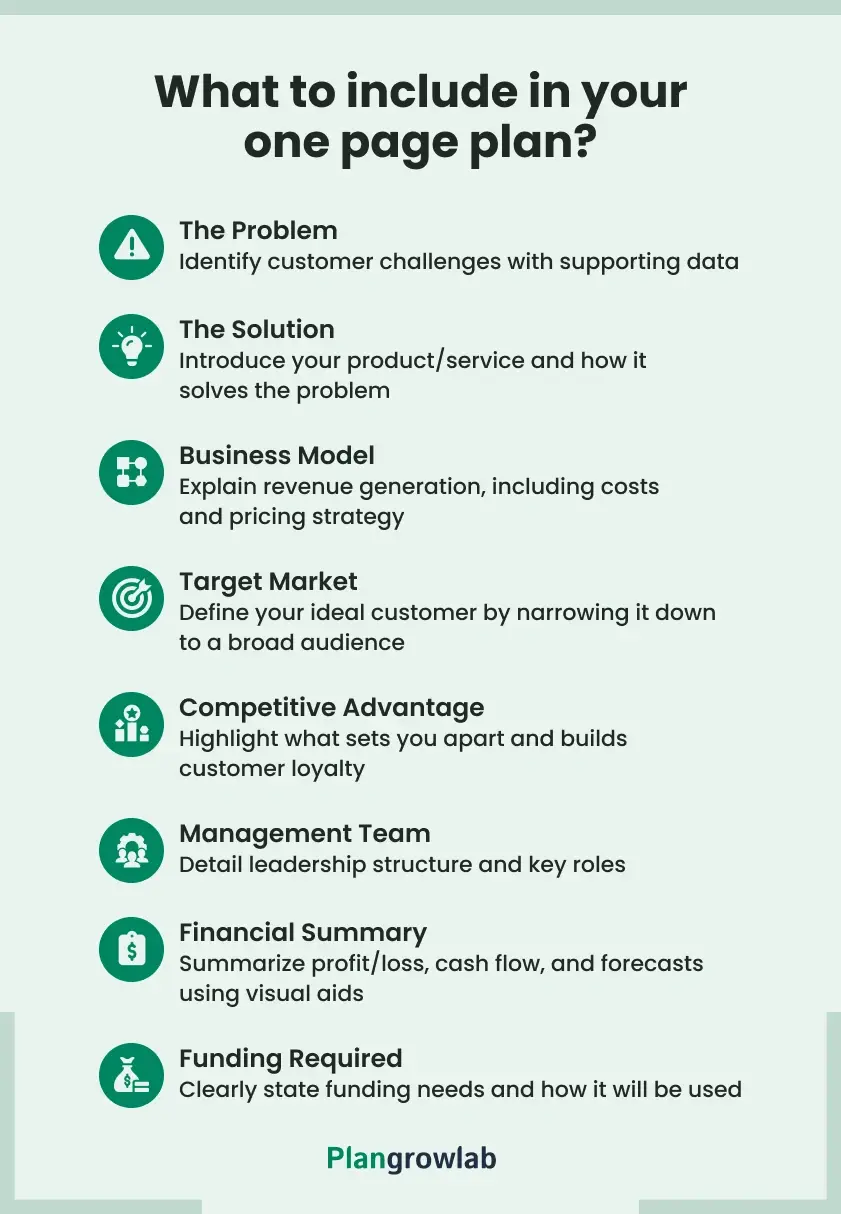Let’s be honest—writing a business plan sounds about as exciting as watching paint dry.
But what if you could do it on just a single page? Yep, just one. No fluff, no unnecessary details—just the important stuff. That’s what a one-page business plan does.
It’s all about capturing the core aspects—what problem you’re solving, how you’re solving it, who’ll buy from you, and how you’ll make money—all without losing your sanity.
But that’s where it gets tricky as well. Often, entrepreneurs get confused about what to include and what to leave out.
That’s why we’ve created a detailed guide on one page business plan, walking you through what to include and what to skip. Plus, we will also give you a one-page business plan template to start with.
What is a one-page business plan?
A one-page business plan directly describes your business concept on one page. It briefs your mission, vision, target market, value proposition, financial summary, marketing strategy, and major objectives. It portrays your business idea instantly to investors, business partners, or employees. Keeping it short and simple enables you to stick to your targets without losing focus on variations.
Traditional vs. one-page business plan
A traditional business plan goes into each detail, including market research, financial projections, and operational strategies, usually spanning multiple pages. It's excellent for long-term planning and raising capital.
Alternatively, a one-page business plan is concise. It puts the most important stuff on one page, like your business concept, mission, target audience, and objectives. It's more convenient to revise and distribute, making it ideal for fast pitches or keeping the main idea at hand.
What makes a one-page plan particularly effective is its emphasis on value creation. Instead of getting lost in detailed projections, it keeps you focused on solving real problems for your customers. After all, if you can clearly communicate the value you’re delivering, the money will follow.
As Allan Dib, the author of The 1-Page Marketing Plan, says, “Focusing on the cause (value) rather than the effect (making money) will lead to much greater long-term success.”
When should you create a one-page business plan?
Though there are various reasons to write a business plan, for a one-page plan, these are some of the non-negotiable scenarios:
To validate your idea
Let’s say you’re testing out the latest business idea and want to see if it’s even worth pursuing. Once you bounce off the plan with your investors—you’ll understand whether it’s worth getting funding.
Before you write a traditional plan
In case you’re planning to write a detailed business plan, a one-page version lets you outline the main pointers first. Once you have the pointers ready, it becomes easy to write the longer version later.
While making quick pitches
A one-page business plan is ideal for quickly communicating your business idea or sparking interest among investors. It’s especially a great approach if you have a time crunch.
For early-stage startups
A one-page business plan is great for early-stage startups that don’t have much data to present and just want to stick to the essentials.
What to include in your one page plan?
Here are the following business plan components that you’ll need to include in your one-page business plan format:

1. The problem
Talk about the specific challenge your customers generally face in your target market. Now, back up your statement with relevant data to show there’s a genuine requirement for your product/service.
2. The solution
Once you’ve explained the problem, now promptly introduce the solution and brief about how it can solve the problem of your target audience.
3. The business model
Now, it’s time to explain your business model and show how it will generate revenue—do not forget to include production costs, selling costs, and as well as the pricing strategy.
4. The target market
Start with a broader audience and then narrow it down to a specific group to define your ideal market and where your target customers fit in.
5. Your competitive advantage
Explain briefly what sets you apart from your competitors. Try to highlight the unique features or approaches that will help you build customer loyalty.
6. Your management team
Try to give a company description that details the complete leadership structure and the key roles, the type of talent you plan to employ, and any gaps you’re planning to fill.
7. Your financial summary
Try to summarize all your key financial metrics, such as profit and loss, cash flow, balance sheets, and sales forecasts. You can also use visual tools like charts and graphs to present the information concisely.
8. The required funding
Clearly state how much funding you need and outline how you’ll be using that money to improve your business or organization.
Tips to create a one-page business plan
Here are some quick and effective tips for creating a one-page business plan:
- Make it simple: Do not use technical jargon or detailed descriptions. Write your ideas using clear and concise language.
- Keep it short: Use brief sentences and bullet points to make your plan easy to read and grasp.
- Include major points only: Only add the most essential pieces—problem, solution, business model, target market, competitive edge, team, finances, and funding required.
- Prioritize clarity over detail: Give the reader enough information to get your point across without drowning them in details. Hold back on detailed information for follow-up discussions.
- Use visuals judiciously: Add simple graphs, charts, or icons to highlight important financial statistics or market data, but don't overwhelm the page.
- Be flexible: A one-page plan is supposed to be fluid. Be willing to revise and update it as your idea changes or as you get feedback.
- Make it action-oriented: Add definite goals and actions to follow to demonstrate that you're committed to taking your plan further.
Download one page business plan template
If you’re ready to get your business idea off the ground but don’t want to get tangled up in a lengthy business plan, a one-page business plan is exactly what you need.
This template helps you zero in on the essentials: What problem are you solving? How will you make money? Who are your customers? By keeping it brief and focused, you get a clear snapshot of your idea that’s easy to share and quick to adjust as your vision evolves.
Whether you’re validating a new idea, preparing for a quick pitch, or just trying to make sense of everything swirling around in your head, this one-page template keeps you on track without getting overwhelmed.
What about the traditional business plan
A one-page plan is great for getting your ideas down fast, but if you’re serious about growing your business or looking for funding, you’ll eventually need a full-blown business plan.
The thing is, writing a traditional business plan can be a real headache. It’s detailed, time-consuming, and, honestly, easy to get stuck on the financials or market research.
That’s why a lot of people turn to consultants. At Plangrowlab, our business plan consultants know the ins and outs and can get the job done way faster than going at it alone. Plus, they’ll help you polish your ideas and put together a plan that actually gets results.
If you’re feeling stuck or just want to get it done without the hassle, bringing in some expert help might be the best move.
Frequently Asked Questions
Will a one-page business plan be accepted by investors or lenders?
It depends on the investor or lender. Some may accept a one-page business plan as a starting point, especially if you’re pitching an early-stage idea. However, most investors and lenders will eventually ask for more detailed financial projections and market analyses. In such cases, use the one-page plan to grab their attention and then provide a more comprehensive version when needed.
What do I do if I need more than one page for my business plan?
If one page isn’t enough, try to focus on the most essential points and keep your language concise. If you still need more space, consider expanding to a two-page version or transitioning to a more detailed traditional business plan.
How detailed should my one-page business plan be?
Your one-page business plan should be detailed enough to clearly communicate your company idea, target market, value proposition, and key objectives, but it shouldn’t get bogged down in specifics. Focus on the big picture and keep it concise. The goal is to provide enough information to spark interest and start a conversation.
Is a one-page business plan suitable for all types of businesses?
No, a one-page business plan isn’t suitable for every business. It works best for startups, small businesses, or projects in the idea validation stage. It’s also great for quick pitches or internal strategy alignment. However, more complex businesses, especially those seeking large investments or operating in highly regulated industries, will likely need a detailed, traditional business plan.

